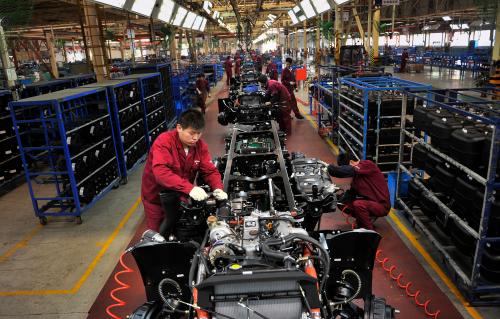Content from the Brookings-Tsinghua Public Policy Center is now archived. Since October 1, 2020, Brookings has maintained a limited partnership with Tsinghua University School of Public Policy and Management that is intended to facilitate jointly organized dialogues, meetings, and/or events.
David Dollar interprets China’s newly released first quarter macro economic data and concludes that China’s growth and financial stability look assured. This piece originally appeared in The Hill.
China’s first-quarter economic numbers were mostly good news, with GDP growth (year-on-year) accelerating modestly to 6.9 percent, up from 6.8 percent in the previous quarter and 6.7 percent for all of 2016.
The GDP growth is based on domestic consumption, rather than investment, as in the past. The China story of the past few years is that investment growth has been slowing after a binge in the period following the global financial crisis.
The result of the investment boom was excess capacity in real estate (especially third- and fourth-tier cities), heavy industry and local government infrastructure. Investment growth has naturally slowed down in the face of excess capacity, declining returns and diminished new investment opportunities.
Consumption growth, on the other hand, has held up well. The accompanying chart shows the contributions of consumption and investment to China’s GDP growth (each series is a four-quarter moving average to address seasonality and smooth the trend). Since 2011, consumption has been the main source of demand.

In the past few quarters, it has been providing 4.8 percentage points of GDP growth. Consumption is mostly services-based, so this is driving the expansion of the service sectors. They are more labor-intensive than industry, so the vast majority of job creation is occurring here as well. The labor market remains tight, wages are rising and that spurs the growth of consumption.
During the long slowdown of investment growth, there was always a worry of how far it was going to go. Now it seems to have stabilized at a low level. In the past four quarters, investment contributed 2.4 percentage points of growth. The other source of growth on the demand side is change in net exports.
This factor has been making small negative contributions as China’s trade surplus declined. In the first quarter of 2017, it made a small positive contribution of 0.3 percentage point. Hopefully, this will not be the beginning of a trend for China’s surplus to expand — that would be bad for the global economy and likely ignite trade tensions with the Trump administration.
The fact that investment growth has stabilized at a low level does not mean that China is necessarily out of the woods in terms of financial stability. During the investment boom, there was an alarming run-up in the debt-to-GDP ratio, an issue acknowledged in speeches and press conferences around the National People’s Congress.
China’s leaders see this as a medium-term problem, not an immediate threat. Their strategy is to slow the growth of leverage and eventually stabilize it. In the first quarter of 2017, total social financing, a broad measure of total credit and finance, increased by 6.9 trillion yuan (more than $1 trillon).
The stock of financing at end-March was up 12.5 percent from the year before. So, while investment has slowed, it is taking a lot of finance to generate that investment. Private investment, in particular, has slowed down and a disproportionate share of investment is coming from government infrastructure projects and state enterprise expansion.
So, overall debt-to-GDP is likely to keep rising in China, just at a slower pace than in the past. The leaders are counting on various features of their country to prevent the kind of financial crises that have plagued other economies in which we have seen this kind of run-up in leverage.
These features include a state-owned banking system that mostly lends to state enterprises and local governments; a closed capital account limiting the options of households to invest elsewhere; and micro-management of the housing market through mortgage terms and control of land.
China can likely avoid a financial crisis, but all of these instruments are distortions that hamper the long-term growth of the economy.
China’s growth and financial stability look assured for this political year that ends with the 19th Party Congress, at which a new leadership team will be unveiled.
The key question then will be whether the leaders undertake the kinds of bold reform of state enterprises, finance and the many still-closed sectors of the economy that would reduce financial risks and enable the economy to continue to grow well.
The Brookings Institution is committed to quality, independence, and impact.
We are supported by a diverse array of funders. In line with our values and policies, each Brookings publication represents the sole views of its author(s).










Commentary
Op-edIn year of big political decisions, Chinese economy appears stable
April 20, 2017